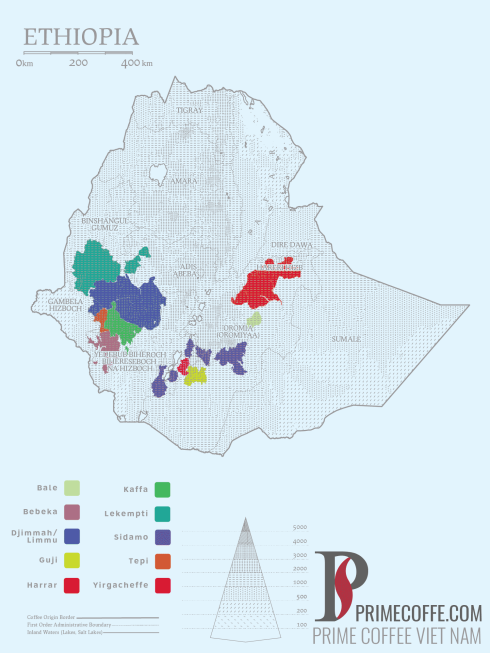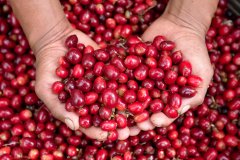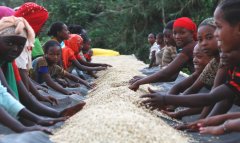Story of planting grades in Ethiopian Coffee producing area characteristics of flavor and taste of Yega Sidamo coffee beans
As we all know, Ethiopia is the birthplace of coffee. Coffee is the main export commodity grown in Ethiopia. Coffee grown in Ethiopia is famous for its excellent quality and flavor. To this day, Ethiopia is one of the world's largest coffee producers and exporters and is in a leading position in the world. Ethiopia is a global coffee mecca. It plays an important role in the genetics of coffee varieties, with a century-old culture of legends and beliefs related to coffee.

The legend of Ethiopian coffee has a saying about the 9th century Ethiopian shepherd Kardi, who noticed that his sheep had an exhilarating effect when they ate the bright red berries of a certain bush. so he chewed the fruit himself. His excitement prompted him to bring the berries to a monk in a nearby temple. But the monk did not agree to use them and threw them into the fire, which wafted an attractive fragrance and attracted the attention of other monks. The roasted coffee beans were soon plucked from the fire, ground and dissolved in hot water, producing the world's first cup of coffee. Since this story did not appear in writing before 1671, that is, 800 years after it was thought to have happened, it is likely to be the Book of Heaven. To this day, thousands of excellent varieties are still scattered in the natural virgin forests and coffee gardens across Ethiopia, which is an invaluable genetic treasure trove of Arabica species. Ethiopia is not only proud of the home country of coffee, but also the only country in Africa that has not been colonized. Therefore, so far, the World Coffee Research Organization is still unable to obtain the consent of the Ethiopian government to enter the genetic treasure house, and can only collect and develop seeds in the peripheral areas of South Sudan and Congo.
Ethiopia is a complex coffee producing area, including Sidama, Yirgacheffe, jimma and Harar. Here, the editor simply creates a mind map to lead you to divide the regions:

There are three main coffee producing areas in Ethiopia: Yegasue, Sidamo, and Harald, each of which consists of many smaller areas with its own specific tastes and methods of handling, but in general, all have a high market share. Harald Harar-Haller, Ethiopia's oldest coffee producing region, is located in the highlands of eastern Ethiopia. This is one of the oldest coffee producing areas still in production. The pods of coffee beans are used in a kind of tea called hasher-qahwa. Harald coffee is characterized in that it is graded and processed almost entirely by hand. Unlike some other coffee producing areas in Ethiopia, Harald coffee is not concentrated wet processing in micro areas (coffee processing stations), but dry by natural drying. Although the processing is done by hand, staff know very well how to classify each coffee bean, and these factors have helped to bring Harar into the top 10 best coffee in the world.
Yeah, Chevy Coffee.
In contrast to Harald, Yega Xuefei is a special wet coffee producing area, with coffee plantations growing between 1700 and 2200 meters above sea level. It is one of the highest coffee producing areas in southern Ethiopia. Coffee higher than Yega Chuefei is eligible to be Strictly Hard Gown (SHG) / (SHB) coffee. Conditions allow coffee plants to grow slowly so that they can accumulate nutrients and form the best flavor in coffee beans. Rated as one of the best Ethiopian coffees on earth, Yega Chefe Coffee is only one grade lower than Harald Coffee among the 10 best coffees in the world. It is characterized by lemon and fruit flavors, light texture and mild sweetness.
From an outsider's point of view, this adds to the enormous complexity of Ethiopian coffee, making it difficult to fully understand-culturally, politically, economically, and culturally simply. In addition, the genetic diversity of coffee here is unparalleled globally-coffee in Ethiopia alone contains 99% more genetic material than in other parts of the world, and the result is the dream of coffee lovers. No coffee can be revered and talked about as romantically as Ethiopian coffee.
Important Notice :
前街咖啡 FrontStreet Coffee has moved to new addredd:
FrontStreet Coffee Address: 315,Donghua East Road,GuangZhou
Tel:020 38364473
- Prev

Esmeralda Manor Palmyra Kaduai Coffee Bean Flavor Taste Characteristics How to brew and drink
In addition to the famous rose summer coffee, there are other excellent coffees waiting to be known in the Esmeralda estate that pays attention to sustainability, quality and innovation. Last time, we took you to see the Diamond Mountain series of Kadura coffee beans. Today, we continue to introduce Palmyra coffee to everyone. Palmyra Estate Coffee is a catuai coffee because of its consistency.
- Next

Cultural ceremony of coffee in Ethiopia and Ethiopia how to drink COE22 and TOH coffee beans and their flavor and taste description
In addition to its rich biological origin, coffee also plays an important role in the culture of this country. The coffee ceremony (Coffee Ceremony) is part of the life of the Ethiopian people and dates back to centuries. Every morning, the women in the family bake fresh coffee and spices on the wacheff. Freshly roasted coffee beans are finely ground, carefully roasted and put in
Related
- Detailed explanation of Jadeite planting Land in Panamanian Jadeite Manor introduction to the grading system of Jadeite competitive bidding, Red bid, Green bid and Rose Summer
- Story of Coffee planting in Brenka region of Costa Rica Stonehenge Manor anaerobic heavy honey treatment of flavor mouth
- What's on the barrel of Blue Mountain Coffee beans?
- Can American coffee also pull flowers? How to use hot American style to pull out a good-looking pattern?
- Can you make a cold extract with coffee beans? What is the right proportion for cold-extracted coffee formula?
- Indonesian PWN Gold Mandrine Coffee Origin Features Flavor How to Chong? Mandolin coffee is American.
- A brief introduction to the flavor characteristics of Brazilian yellow bourbon coffee beans
- What is the effect of different water quality on the flavor of cold-extracted coffee? What kind of water is best for brewing coffee?
- Why do you think of Rose Summer whenever you mention Panamanian coffee?
- Introduction to the characteristics of authentic blue mountain coffee bean producing areas? What is the CIB Coffee Authority in Jamaica?

